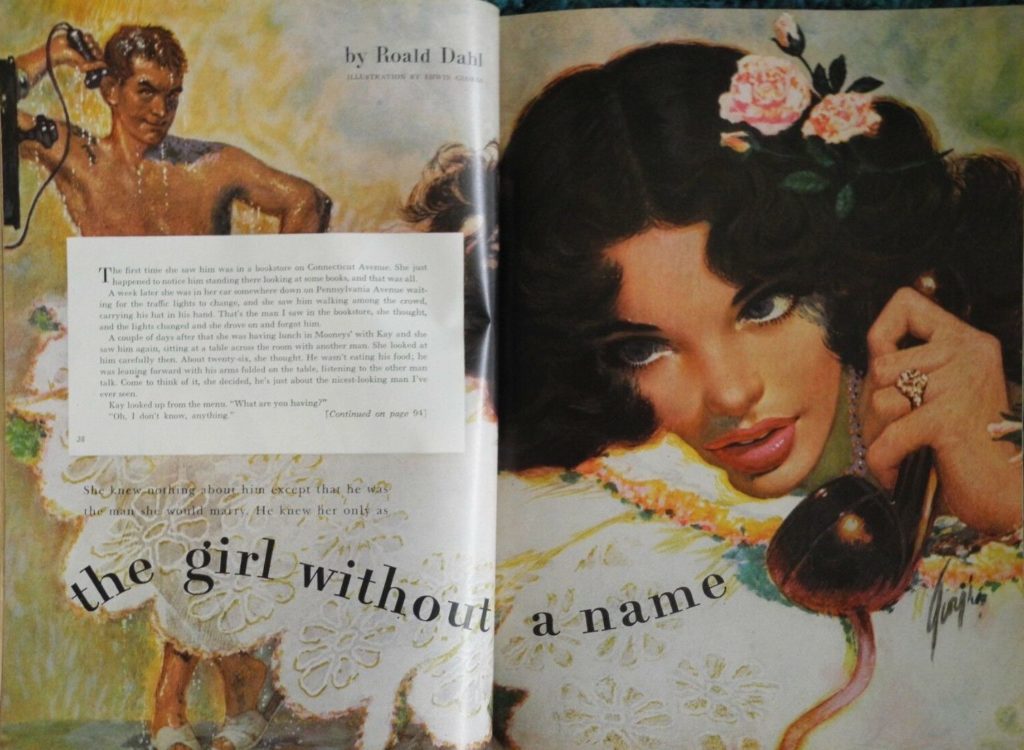Sections: Information
Information
- Written in 1950
- Listed in the Bibliography of Sturrock’s biography as unpublished.
Sections: Information
Sections: Information
Sections: Information
Sections: Information
Sections: Information
In a Chapter 7 footnote, Sturrock writes of Dahl’s real-life RAF squadron commanding officer:
With his broad shoulders and bushy mustache, Tap Jones was clearly the model for Monkey, the squadron leader in Dahl’s unpublished short story, The Ginger Cat. There Dahl describes him as “a big fine man with a black mustache.” — RSMSC 5/14/1-3
Sections: Information | Description
From Sturrock’s Storyteller:
A child discovers that his uncle Aristotle has invented a machine for listening to conversations from the past and uses it to prove that a certain Benjamin Bluebottle is guilty of the murder of Miss Jemima Redbottom.
Sections: Information | Plot Description
Spoiler warning! This is a very short little story in which a British butler and a French chef outwit an obnoxious nouveau riche millionaire (probably meant to be American, judging by his name and accent). This millionaire, Mr. Cleaver, wants desperately to become the toast of society. He throws dinner many dinner parties, but none of them ever really seems to “come off.” The butler, Tibbs, explains that this is because the host serves the guests a “cheap and very odious Spanish red [wine].” At his employer’s request, then, Tibbs begins stocking the wine cellar with some of the most rare and exquisite and expensive wines in the world. Mr. Cleaver even studies to become a wine connoiseur. The parties, however, do not improve. Tibbs then explains that this is because Mr. Cleaver has instructed the chef to prepare the salad dressing with vinegar. Vinegar, he explains, is the enemy of wine and leaves you unable to taste it. “Hogwash,” says his employer. That very same night Mr. Cleaver begins to expound upon the virtues of the French wine he believes he is drinking… until Tibbs points out that it is the same cheap and odious Spanish red that he has always served. He claims that great wines should be revered and that he and Monsieur Estragon, the chef, have finished all of the bottles themselves. Then he walks out the door to the waiting car Monsieur Estragon has already packed with their belongings.
Sections: Information | Plot Description
Spoiler warning! The year is 1946 and an old man named Drioli shuffles across the Parisian street in the freezing cold. He stops before a picture gallery to admire the painting in the window… and suddenly recognizes the name of the artist. “Chaim Soutine… My little Kalmuck, that’s who it is!” Drioli remembers a night thirty years before, when he had come home from his tattoo parlor flush with cash and bearing bottles of wine. The boy (Soutine) had been painting a picture of Drioli’s wife, with whom he was infatuated. The three of them get very drunk and Drioli comes up with an idea – he wants the boy to paint a picture on his back and then tattoo over it! The boy only agrees when Drioli’s wife Josie says she will pose for the picture. It takes all night, but eventually the picture is finished and signed. Not long after, the boy disappeared and they never saw him again. Josie died during the second World War and Drioli’s tattooing business collapsed. Now, in the present, he is reduced to begging in the streets. He decides to go in and see the other Soutine pictures on display. The gallery workers try to throw him out, but before they can he takes off his shirt and shows the crowd his tattooed back. They are amazed and immediately several men offer to buy the painting from him. Eventually Drioli is faced with a choice: one man offers to pay for a major skin-grafting operation, while another simply asks Drioli to come live at his hotel (the Bristol in Cannes) and exhibit the painting to his guests. Drioli chooses the latter and goes off to dinner with the man. Not long after, a strange painting by Soutine shows up for sale in Buenos Aires. And, the narrator tells us, there is no hotel called the Bristol in Cannes.
Sections: Information | Description | Magazine Scan
From an eBay auction by purviswalker1: “Another astonishingly rare title in Dahl’s output… The story was first published in Today’s Woman and saw two reprints – one in the Woman’s Journal of the following year and one in a news paper under an alternative title. The short story never surfaced again and is extremely difficult to find. It is a rather curious tale for the ‘master of the macabre’, in that it reads like a teen romance(!). The Dahl museum has the manuscript, the ending of which is a little different than the published version as there were a few editorial changes.”
November 1951 issue of Today’s Woman

Sections: Information | Fun Stuff